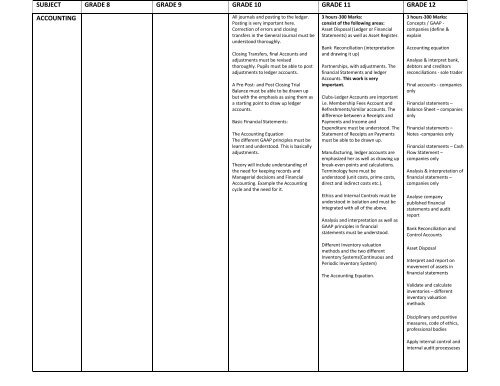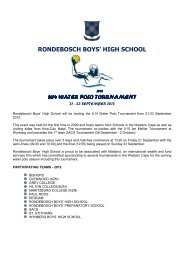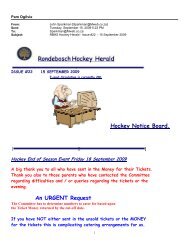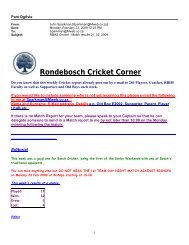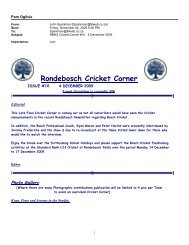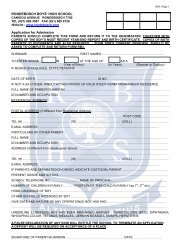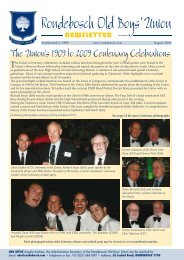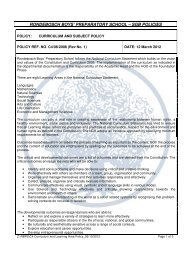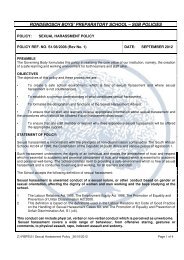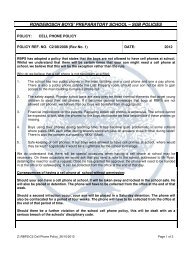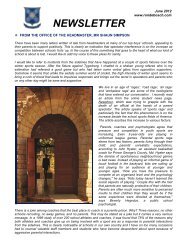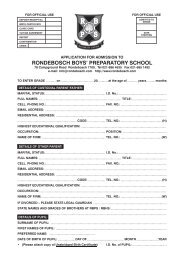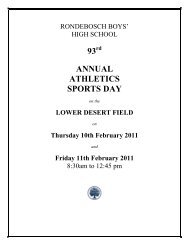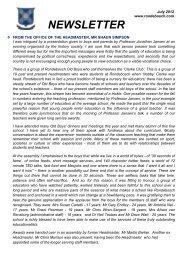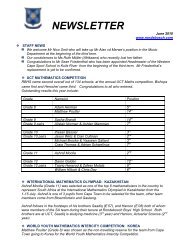Asset Disposal (Ledger or Financial Statements)
Asset Disposal (Ledger or Financial Statements)
Asset Disposal (Ledger or Financial Statements)
You also want an ePaper? Increase the reach of your titles
YUMPU automatically turns print PDFs into web optimized ePapers that Google loves.
SUBJECT GRADE 8 GRADE 9 GRADE 10 GRADE 11 GRADE 12<br />
ACCOUNTING All journals and posting to the ledger.<br />
Posting is very imp<strong>or</strong>tant here.<br />
C<strong>or</strong>rection of err<strong>or</strong>s and closing<br />
transfers in the General Journal must be<br />
understood th<strong>or</strong>oughly.<br />
Closing Transfers, final Accounts and<br />
adjustments must be revised<br />
th<strong>or</strong>oughly. Pupils must be able to post<br />
adjustments to ledger accounts.<br />
A Pre-Post- and Post Closing Trial<br />
Balance must be able to be drawn up<br />
but with the emphasis as using them as<br />
a starting point to draw up ledger<br />
accounts.<br />
Basic <strong>Financial</strong> <strong>Statements</strong>:<br />
The Accounting Equation<br />
The different GAAP principles must be<br />
learnt and understood. This is basically<br />
adjustments.<br />
The<strong>or</strong>y will include understanding of<br />
the need f<strong>or</strong> keeping rec<strong>or</strong>ds and<br />
Managerial decisions and <strong>Financial</strong><br />
Accounting. Example the Accounting<br />
cycle and the need f<strong>or</strong> it.<br />
3 hours-300 Marks:<br />
consist of the following areas:<br />
<strong>Asset</strong> <strong>Disposal</strong> (<strong>Ledger</strong> <strong>or</strong> <strong>Financial</strong><br />
<strong>Statements</strong>) as well as <strong>Asset</strong> Register.<br />
Bank Reconciliation (interpretation<br />
and drawing it up)<br />
Partnerships, with adjustments. The<br />
financial <strong>Statements</strong> and ledger<br />
Accounts. This w<strong>or</strong>k is very<br />
imp<strong>or</strong>tant.<br />
Clubs-<strong>Ledger</strong> Accounts are imp<strong>or</strong>tant<br />
i.e. Membership Fees Account and<br />
Refreshments/similar accounts. The<br />
difference between a Receipts and<br />
Payments and Income and<br />
Expenditure must be understood. The<br />
Statement of Receipts an Payments<br />
must be able to be drawn up.<br />
Manufacturing, ledger accounts are<br />
emphasized her as well as drawing up<br />
break-even points and calculations.<br />
Terminology here must be<br />
understood (unit costs, prime costs,<br />
direct and indirect costs etc.).<br />
Ethics and Internal Controls must be<br />
understood in isolation and must be<br />
integrated with all of the above.<br />
Analysis and interpretation as well as<br />
GAAP principles in financial<br />
statements must be understood.<br />
3 hours-300 Marks:<br />
Concepts / GAAP -<br />
companies (define &<br />
explain<br />
Accounting equation<br />
Analyse & interpret bank,<br />
debt<strong>or</strong>s and credit<strong>or</strong>s<br />
reconciliations - sole trader<br />
Final accounts - companies<br />
only<br />
<strong>Financial</strong> statements –<br />
Balance Sheet – companies<br />
only<br />
<strong>Financial</strong> statements –<br />
Notes -companies only<br />
<strong>Financial</strong> statements – Cash<br />
Flow Statement –<br />
companies only<br />
Analysis & interpretation of<br />
financial statements –<br />
companies only<br />
Analyse company<br />
published financial<br />
statements and audit<br />
rep<strong>or</strong>t<br />
Bank Reconciliation and<br />
Control Accounts<br />
Different Invent<strong>or</strong>y valuation<br />
methods and the two different<br />
Invent<strong>or</strong>y Systems(Continuous and<br />
Periodic Invent<strong>or</strong>y System)<br />
The Accounting Equation.<br />
<strong>Asset</strong> <strong>Disposal</strong><br />
Interpret and rep<strong>or</strong>t on<br />
movement of assets in<br />
financial statements<br />
Validate and calculate<br />
invent<strong>or</strong>ies – different<br />
invent<strong>or</strong>y valuation<br />
methods<br />
Disciplinary and punitive<br />
measures, code of ethics,<br />
professional bodies<br />
Apply internal control and<br />
internal audit processeses
AFRIKAANS GRADE 8 GRADE 9 GRADE 10<br />
Vraestel 2 [70]:<br />
K<strong>or</strong>tverhale<br />
Verdwyning van Flip Loots<br />
Just you<br />
Shwarzenegger<br />
Vliegles<br />
(Daar sal ‘n keuse wees<br />
tussen Opsteltipe vrae en K<strong>or</strong>t vrae.)<br />
Gedigte<br />
Verkeerslig<br />
Gebrek aan ‘n tuin<br />
Knipmes<br />
Om groot te w<strong>or</strong>d<br />
Vraestel 1 [80]<br />
Fokus op alle taalaspekte<br />
wat vanaf Gr. 8 gedoen is:<br />
bv. Meervoude, Verkleinwo<strong>or</strong>de,<br />
Byvoeglike Naamwo<strong>or</strong>de,<br />
Tye, Direkte en Indirekte Rede,<br />
Lydende V<strong>or</strong>m, Voegwo<strong>or</strong>de,<br />
ens. en raadpleeg gerus die<br />
“Afrikaans Study Guide” vir<br />
die grammatika in Afdeling C.<br />
GRADE 11<br />
VRAESTEL 3 SKRYF VRAESTEL [100]<br />
Daar sal van jou verwag w<strong>or</strong>d om 3<br />
(drie) skryfstukke aan te bied<br />
in die twee en ‘n half uur eksamen.<br />
Lees die instruksies noukeurig deur.<br />
Beplan jou werk en bied dit aan as<br />
deel van die vraestel.<br />
VRAESTEL 2 LETTERKUNDE [80]<br />
Maak seker dat die volgende<br />
vo<strong>or</strong>bereiding gedoen is vir die<br />
vraestel:<br />
a)K<strong>or</strong>t verhale<br />
Die Engelman - Izak de Vries<br />
Mutsuku- Izak de Vries<br />
Die werksmanne van Slovoville [20]<br />
b)Roman<br />
Skilpoppe- Barrie Hough Hoofstuk 1-6<br />
[20]<br />
c)Gedigte<br />
Rondloper<br />
Ek is oek imp<strong>or</strong>tant<br />
Ken jy die see …<br />
Gedagtes van die beseerde arbeider<br />
Gedagtes van die nie-arbeider<br />
Harlekyn van die dieretuin<br />
Hansie and Grietjie (4x10) =[40]<br />
VRAESTEL 1 BEGRIP EN TAAL<br />
Hierdie vraestel bestaan uit DRIE<br />
afdelings. [80]<br />
AFDELING A: LEESBEGRIP<br />
(VRAAG 1, 2 en 3) [35]<br />
AFDELING B: OPSOMMING<br />
(VRAAG 4) [10]<br />
AFDELING C: KOMMUNIKATIEWE<br />
TAALGEBRUIK (VRAAG 5, 6 en 7) [35]<br />
GRADE 12<br />
Afdeling A: Begripstoets [35]<br />
Afdeling B: Opsomming [10]<br />
Afdeling C: Taal [35]
SUBJECT GRADE 8 GRADE 9 GRADE 10 GRADE 11 GRADE 12<br />
EMS<br />
Economic Cycle<br />
Fact<strong>or</strong>s of production<br />
Economic Systems (Controlled,<br />
Market, Mixed)<br />
Hist<strong>or</strong>ical Development of<br />
Money<br />
Security features of money<br />
Inflation<br />
Budgets<br />
Personal budget<br />
(different types of<br />
expenses)<br />
National budget<br />
(different types of<br />
taxes)<br />
Different types of investments<br />
Interest calculations<br />
Simple interest<br />
F<strong>or</strong>ms of ownership<br />
Compound interest<br />
The exam will consist of:<br />
Sh<strong>or</strong>t questions<br />
Case Studies<br />
Calculations/graphs and<br />
Accounting principles and<br />
applying business case studies.<br />
Understanding principles from<br />
the National Budget and tax<br />
collection from the learners own<br />
research projects and discussion<br />
and notes in class.<br />
Different Economic Systems and<br />
the Economic Cycle (Must be<br />
able to understand how the<br />
fact<strong>or</strong>s of production and their<br />
reward fit into the Economic<br />
Cycle). Learners must be able to<br />
draw the Economic Cycle.<br />
Understand international<br />
exchange and be able to draw a<br />
graph representing the exchange<br />
rate and how this has an effect<br />
on Imp<strong>or</strong>ts and Exp<strong>or</strong>ts. How this<br />
benefits certain sect<strong>or</strong>s in the<br />
economy.<br />
Understand the laws of demand<br />
and supply in a perfect economy<br />
context. Be able to draw up an<br />
equilibrium point and then<br />
understand what happens when<br />
this equilibrium point is not<br />
reached.<br />
Economic Growth and<br />
Development. Understand how<br />
these can be obtained. Need to<br />
understand the RDP and what<br />
the government policy is on it.<br />
How Tax is collected and the<br />
different types of tax(Case<br />
Studies and problem solving<br />
questions)<br />
Must understand the SA Budget<br />
and how it is drawn up and the<br />
basic components of this year’s<br />
Budget.<br />
Cont…
EMS<br />
GRADE 9<br />
Trade Unions. Why they are<br />
there and the disadvantages and<br />
advantages of Trade Unions.<br />
Briefly understand. Need to<br />
understand a sh<strong>or</strong>t hist<strong>or</strong>y of<br />
Trade Unions and the various<br />
Trade Unions in SA.<br />
Accounting:<br />
Definitions of Accounting and<br />
<strong>Asset</strong>s, Owners Equity and<br />
Liabilities<br />
The classification of these<br />
accounts into the above groups<br />
The accounting equation<br />
(effect/reason)
ENGINEERING<br />
DESIGN &<br />
GRAPHICS<br />
GRADE 8 GRADE 9 GRADE 10<br />
2 Hour Paper 200 marks<br />
1. Analytical<br />
2. Section through geometric<br />
solid with true shape of<br />
section<br />
3. Isometric/Oblique<br />
4. Machine assembly drawing<br />
GRADE 11<br />
3 Hour Paper 200 marks<br />
1. Mechanical – analytical<br />
2. Sections through<br />
geometrical solids with<br />
true shape of section<br />
3. Interpenetrations and<br />
surface development of<br />
the penetrations<br />
4. Isometric drawing<br />
5. Machine assembly<br />
drawing<br />
GRADE 12<br />
Paper 1 (Civil) 3 Hour<br />
100 marks<br />
Analytical (the<strong>or</strong>y)<br />
Development<br />
Interpenetrations (+<br />
development of it) –<br />
transition pieces<br />
2-Point perspective<br />
House – no rebated walls –<br />
no arches/circles<br />
Civil assembly<br />
foundation to flo<strong>or</strong> height<br />
– Plans (no wiring<br />
diagrams)<br />
Paper 2 (Mechanical)<br />
3 Hour 100 marks<br />
Analytical (the<strong>or</strong>y)<br />
Loci<br />
Helix on cylinders and<br />
cones<br />
Isometric drawings<br />
Sectioned - circles<br />
Mechanical assembly
ENGLISH GRADE 10<br />
Literature:<br />
Be prepared to answer contextual<br />
questions and to write a critical essay<br />
on Romeo and Juliet.<br />
F<strong>or</strong> poetry you will need to revise<br />
the printed poetry issued to you<br />
f<strong>or</strong> terms one and two so that<br />
you can answer contextual questions<br />
and write an essay on a poem. You also<br />
need to prepare yourself f<strong>or</strong> an unseen<br />
(not studied <strong>or</strong> read in class) poem.<br />
Total: 80 marks<br />
Language: Revise comprehension,<br />
summary, advertising, visual literacy,<br />
editing, punctuation , and err<strong>or</strong>s of<br />
grammar.<br />
Total: 70 marks<br />
Writing: Prepare f<strong>or</strong> three sections:<br />
A. a f<strong>or</strong>mal, discursive, descriptive,<br />
reflective <strong>or</strong> narrative essay f<strong>or</strong> 50<br />
marks;<br />
B. a letter to the press, film <strong>or</strong><br />
book review, <strong>or</strong> restaurant review f<strong>or</strong><br />
30 marks;<br />
C. directions, speech, diary<br />
extract, flyer, invitation, advert f<strong>or</strong> 20<br />
marks.<br />
Total: 100 marks
GEOGRAPHY GRADE 8<br />
GRADE 9<br />
GRADE 10<br />
GRADE 11 GRADE 12<br />
100 Marks -1 Hour<br />
W<strong>or</strong>k to be examined:<br />
100 Marks - 1.25 hours<br />
General : The exam will be<br />
based on a 1:50 000 Map<br />
140 marks The<strong>or</strong>y<br />
60 marks Mapw<strong>or</strong>k<br />
The<strong>or</strong>y 200<br />
Mapw<strong>or</strong>k 100<br />
1) Data handling<br />
2) SA Africa (rivers/<br />
mountains/ relief features/<br />
Ocean currents, neighbours/<br />
provinces/ capitals etc)<br />
3) Minerals<br />
(diamonds/ gold/ coal/ iron<br />
<strong>or</strong>e)<br />
4) Transp<strong>or</strong>t<br />
5) Globalisation<br />
6) Climate<br />
(will be told how far you will be<br />
examined later)<br />
1) Settlement Geography (1 st<br />
term w<strong>or</strong>k) will be<br />
examined from the map.<br />
2) Mapw<strong>or</strong>k: All<br />
calculations will be<br />
examined<br />
Mapw<strong>or</strong>k Interpretation (eg.<br />
Slopes/ land use/ rivers/ wind<br />
direction etc)<br />
Cross sections will not be<br />
examined in June<br />
GIS will not be examined!<br />
Ensure that you have all<br />
instruments (protract<strong>or</strong>, ruler,<br />
pencil, eraser)<br />
All Geom<strong>or</strong>pholgy (1 st term)<br />
All Population Geography (2 nd term)<br />
Mapw<strong>or</strong>k (Grade 8, 9 and 10)<br />
All Geom<strong>or</strong>phology<br />
All Climatology<br />
South Africa- Rural<br />
Calculations that will be tested:<br />
Directions/ True bearing<br />
Back bearing/ Magnetic bearing<br />
Scale/ Distance<br />
Area<br />
Conventional signs/ slopes<br />
(Learning)<br />
Map titles<br />
Gradient( heights)<br />
Co<strong>or</strong>dinates<br />
Settlement:<br />
Settlement Types (urban/ rural)<br />
Nucleated/ dispersed<br />
Farming (intensive/ extensive)<br />
Settlement shapes/ functions<br />
Land use zones (CBD/ transition<br />
zone/ industrial etc)<br />
Land values<br />
Street patterns<br />
Urbanisation
HISTORY GRADE 8<br />
75 minute paper: 60 marks<br />
W<strong>or</strong>k to be examined:<br />
• French Revolution<br />
• Industrial<br />
Revolution in Britain<br />
and South Africa<br />
Type of material to be used:<br />
• Cartoons, paintings,<br />
sketches and<br />
pictures<br />
• Maps<br />
• Diagrams and<br />
graphs<br />
• Written sources<br />
F<strong>or</strong>mat of the paper:<br />
1. Source-based<br />
questions between<br />
1 and 6 marks each.<br />
2. Extended writing<br />
pieces between 8 to<br />
10 marks each.<br />
Instructions on the front of<br />
the examination paper:<br />
Put your name in the top righthand<br />
side of the front page.<br />
Use f<strong>or</strong>mal English .<br />
Draw mark margins on the<br />
right-hand side of each page.<br />
Leave a line open between<br />
each question.<br />
Rule a mark margin on the<br />
right hand side of each answer<br />
sheet.<br />
Start each SECTION on a fresh<br />
sheet of paper.<br />
Staple your paper together at<br />
the end of the exam.<br />
Requirements:<br />
Stapler, Ruler and Pens<br />
GRADE 9<br />
1.Human Rights Issues During &<br />
After WWII<br />
1.1. What Were Hitler’s<br />
Main Ideas?<br />
1.2. How Did the Nazis<br />
Build the Racial<br />
State?<br />
1.3. What was it like to<br />
be a Min<strong>or</strong>ity Group<br />
in Nazi Germany?<br />
1.4. Book-burning and<br />
the Control of<br />
Knowledge.<br />
1.5. War & the Holocaust.<br />
1.6. Resistance to Hitler<br />
During the War.<br />
2. Genocide in Rwanda<br />
3. The End of WW2 and<br />
Struggle f<strong>or</strong> Human Rights<br />
3.1. United Nations:<br />
Declaration of<br />
Human Rights &<br />
Crimes Against<br />
Humanity<br />
3.2. USA: Civil Rights<br />
Movement<br />
4. Apartheid in South Africa:<br />
4.1. Impact of WW2?<br />
4.2. What was<br />
Apartheid?<br />
4.3. How Did It Affect<br />
People’s Lives?<br />
4.4. Repression &<br />
Resistance to<br />
Apartheid in the<br />
1950s.<br />
4.5. Repression & the<br />
Armed Struggle in<br />
the 1960s<br />
4.6. Building a New<br />
Identity in South<br />
Africa in the 1990s.<br />
4.7. South Africa:What is<br />
Democracy?<br />
The Bill of Rights<br />
F<strong>or</strong>mat: The exam will be<br />
source-based. The inf<strong>or</strong>mation<br />
you are able to extract from<br />
these sources must be combined<br />
with your own knowledge in<br />
<strong>or</strong>der to answer the questions.<br />
There will be source-based<br />
questions as well as extended<br />
writing activities.<br />
GRADE 10<br />
Time: 2rs Marks: 100<br />
Question paper f<strong>or</strong>mat:<br />
3 questions - answer 2<br />
Each question = 50 marks<br />
Material to be examined:<br />
THE WORLD IN 1450 AND<br />
COLONIALISM.<br />
How did the Spanish rule the new<br />
w<strong>or</strong>ld?<br />
The P<strong>or</strong>tuguese and Dutch sea-routes<br />
and settlements<br />
The British<br />
SLAVERY<br />
What part did Africa play in the Atlantic<br />
Slave Trade?<br />
The impact of Slavery<br />
Slave Resistance<br />
What was the effect of slavery on<br />
industrializing Britain?<br />
Slave heritage<br />
QUEST FOR LIBERTY<br />
The American Revolution<br />
Situation bef<strong>or</strong>e the Revolution<br />
The War<br />
What changes were evident after the<br />
War?<br />
Breakdown:<br />
30 marks source-based questions<br />
20 marks extended writing. In this<br />
section there is a choice. Two questions<br />
answer one.<br />
Points to remember f<strong>or</strong> the<br />
examination<br />
Use f<strong>or</strong>mal English at all times unless<br />
stipulated.<br />
Rule a mark margin on the right hand<br />
side of each answer sheet.<br />
Space your w<strong>or</strong>k out neatly.<br />
Start each maj<strong>or</strong> question on a fresh<br />
sheet of paper.<br />
Staple your paper at the end of the<br />
exam bef<strong>or</strong>e handing in.<br />
GRADE 11<br />
FORMAT: One three-hour paper.<br />
Each question counts 50 marks: 30<br />
f<strong>or</strong> source-based questions and 20 f<strong>or</strong><br />
extended writing. Each question will<br />
have an overall key question.<br />
FOUR questions will be set of which<br />
THREE must be answered. Questions<br />
will be set on the following<br />
CONTENT AREAS:<br />
Challenges to capitalism;<br />
Russian Revolution and the<br />
establishment of the Communist<br />
state: Marxism, Leninism and<br />
Stalinism<br />
Crisis of capitalism: The Great<br />
Depression in the USA and its wider<br />
impact in terms of the emergence of<br />
fascist economies and states, e.g.<br />
Nazi Germany.<br />
What was the impact of pseudoscientific<br />
racism and Social Darwinism<br />
on the 19th and 20th Centuries,<br />
including the eugenics movements in<br />
the late 19th Century and its impact<br />
on ideas of race and racism in the<br />
USA, Australia, Europe and<br />
particularly leading to genocide in<br />
Nazi Germany?<br />
Competing Nationalisms and<br />
identities in Africa: The roots of Pan-<br />
Africanism to 1945 and South African<br />
Nationalism and identities.<br />
GRADE 12<br />
ONE paper: three hours<br />
The paper has an overall<br />
key question. Candidates<br />
should construct <strong>or</strong> explain<br />
hist<strong>or</strong>y from source<br />
material.<br />
Paper 1 (3 hours): Set<br />
FOUR questions; answer<br />
TWO.<br />
Overall key question f<strong>or</strong><br />
Paper 1:<br />
‘What legacies of the mid-<br />
20th century have shaped<br />
our present?’<br />
The content framew<strong>or</strong>k f<strong>or</strong><br />
Paper 1:<br />
1. What was the impact of<br />
the Cold War in f<strong>or</strong>ming<br />
the w<strong>or</strong>ld in the 1960s?<br />
• USSR/USA – creating<br />
spheres of interest<br />
• What role did the UN<br />
and other multi-lateral<br />
<strong>or</strong>ganisations such as the<br />
OAU, NAM play in<br />
attempting to mediate<br />
conflict in Africa?<br />
2. How was Uhuru realised<br />
in Africa in the 1960s and<br />
1970s?<br />
3. What f<strong>or</strong>ms of civil<br />
society protest emerged<br />
from the 1960s up to<br />
1990? Focus 1960s: Civil<br />
rights movements and<br />
Black Power movements in<br />
the USA; w<strong>or</strong>ld nuclear<br />
disarmament movements,<br />
peace movements and<br />
women’s movements.<br />
4. Focus 1970s: Black<br />
Consciousness Movement<br />
in South Africa, Apartheid<br />
South Africa in the 1980s.
MATHS GRADE 8 GRADE 9<br />
GRADE 10<br />
GRADE 11<br />
GRADE 12<br />
The real number system<br />
Real, rational, irrational, prime<br />
numbers etc.<br />
Fractions ↔ decimal ↔<br />
percentage<br />
Finance<br />
Ratio & prop<strong>or</strong>tion<br />
Patterns<br />
Algebra<br />
Multiplication of brackets<br />
Pythag<strong>or</strong>as<br />
Fact<strong>or</strong>ising<br />
• Common fact<strong>or</strong><br />
• Common bracket<br />
• Switcharounds<br />
• Difference of two<br />
squares<br />
• Trinomials<br />
Algebraic Fractions<br />
Indices<br />
Probability<br />
Equations (revision from Gr 8)<br />
2hours: 125 marks<br />
Numbers & Patterns<br />
Indices<br />
Products<br />
Fact<strong>or</strong>ising<br />
• Common Fact<strong>or</strong><br />
• Common Brackets<br />
• Switcharounds<br />
• Difference of two squares<br />
• Trinomials<br />
Algebraic Fractions<br />
Equations & inequalities<br />
Measurement (Volume, Surface Area,<br />
Perimeter)<br />
Co-<strong>or</strong>dinate Geometry<br />
Data Handling<br />
• Mean, Median, Mode,<br />
Range, Q1, Q3, IQR, Semi-<br />
IQR<br />
• Frequency Polygon<br />
• Ogive<br />
• Other graphs<br />
2 hours : 100 marks<br />
Paper 1<br />
Numbers & Patterns<br />
Mathematical Finance<br />
Indices & Surds<br />
Algebraic fractions<br />
Quadratic equations & inequalities<br />
Simultaneous Equations<br />
2 hours : 100 marks<br />
Paper 2<br />
Data Handling<br />
• Mean, Median, Mode,<br />
Range, Q1, Q3, IQR, Semi-<br />
IQR<br />
• Frequency<br />
• Ogive<br />
• Other graphs<br />
• Variance & standard<br />
deviation<br />
Co-<strong>or</strong>dinate geometry<br />
Measurement (Volume, Surface<br />
Area, Perimeter)<br />
Trigonometry<br />
• CAST diagrams<br />
• Special Angles<br />
• Identities<br />
• 180⁰ and 90 rules⁰<br />
Paper 1<br />
Exponents and Surds<br />
Algebraic fractions<br />
Quadratic equations and<br />
inequalities<br />
Simultaneous equations<br />
Patterns and Series<br />
Logarithms - solve a x =b<br />
Finance<br />
Solving cubic equations<br />
Graphs<br />
Linear Progamming<br />
Paper 2<br />
Co-<strong>or</strong>dinate Geometry<br />
Trigonometry (CAST<br />
diagram, special<br />
angles, identities, 180 and<br />
90 degree<br />
rules, trig equations,<br />
compound angles,<br />
sine, cos and area rules,<br />
problems in<br />
2 & 3 dimensions, trig<br />
graphs)<br />
Transf<strong>or</strong>mations (Gr 11<br />
only)<br />
Data Handling<br />
2 hours : 100 marks
MATHS<br />
LITERACY<br />
GRADE 11<br />
Paper 1<br />
Paper 2<br />
1. Exponents (Module 1)<br />
2. Roots (Module 2)<br />
3. Linear functions<br />
(Module 3)<br />
4. Compound growth<br />
(Module 4)<br />
5. Data in tallies and tables<br />
(Module 7)<br />
6. Data in pie charts and in<br />
bar graphs (Module 8)<br />
7. Quartiles, variance and<br />
standard deviation<br />
(Module 14)<br />
1. Polygons and circles<br />
(Module 5)<br />
2. Right Prisms and Right<br />
circular cylinders<br />
(Module 6)<br />
3. Ratios and rates<br />
(Module 9)<br />
4. Direct and inverse<br />
prop<strong>or</strong>tions<br />
(Module 10 and 11)<br />
5. Units of<br />
measurement(conversion)<br />
(Module 12)<br />
6. Scale drawings<br />
(Module 13)<br />
GRADE 12<br />
Paper 1<br />
Paper 2<br />
1. Simple<br />
Arithmetic<br />
2. Simple<br />
calculations –<br />
w<strong>or</strong>d problems<br />
3. Calculations<br />
involving the<br />
purchasing of<br />
goods – terms,<br />
tax etc.<br />
4. Calculations<br />
involving<br />
geometric<br />
problems.<br />
5. Statistical<br />
analysis.<br />
1. Problem<br />
involving<br />
financial<br />
budgets etc.<br />
2. Map w<strong>or</strong>k<br />
3. Geometric<br />
problems<br />
4. M<strong>or</strong>e statistical<br />
analysis
MUSIC GRADE 8 GRADE 9 GRADE 10 GRADE 11 GRADE 12<br />
MR.SCARR’S CLASS<br />
1. STAFF NOTATION –<br />
treble and bass clefs<br />
including leger lines<br />
2. THE GRAND STAFF –<br />
know what it is, and<br />
THE POSITION of<br />
MIDDLE C<br />
3. NOTE VALUES AND<br />
RESTS – semibreve,<br />
minim, crotchet and<br />
quaver – including<br />
dotted notes<br />
4. TIME SIGNATURES<br />
5. TONES AND<br />
SEMITONES<br />
6. THE SHARP, FLAT<br />
AND NATURAL –<br />
know the<br />
definitions<br />
7. THE CHROMATIC<br />
SCALE<br />
8. THE MAJOR SCALE –<br />
you must know how<br />
to write maj<strong>or</strong><br />
scales starting on C,<br />
G,D AND F<br />
9. KEY SIGNATURES –<br />
FOR C, G, D, and F<br />
MAJOR<br />
MR V.D MERWE’S CLASS<br />
1) Music The<strong>or</strong>y—<br />
Music AD<br />
THEORY(Yellow<br />
book) PAGES1—36<br />
Aural- Ch<strong>or</strong>d recognition and<br />
Dictation<br />
THEORY-Grade4 Royal schools<br />
pages1-25(old and new book)<br />
HISTORY- THE BEATLES (and<br />
other groups of the60’s) as well<br />
as ELEMENTS of ROCK. See notes<br />
FORM IN MUSIC- See notes<br />
given to you by your teacheryou<br />
will be given pieces to<br />
analyse in the exam- they will be<br />
in BINARY <strong>or</strong> TERNARY FORM.<br />
MRS JOUBERT’S CLASS<br />
1. What is f<strong>or</strong>m in<br />
music?<br />
2. Scales: technical<br />
names, e.g. tonic<br />
3. Write tonic and<br />
dominant triad in a<br />
maj<strong>or</strong> key<br />
4. Cadences – perfect,<br />
imperfect, plagal,<br />
interrupted – know<br />
harmonies<br />
5. Modulation<br />
6. Know key signatures<br />
up to 4 flats and 4<br />
sharps<br />
7. Know how to find<br />
relative min<strong>or</strong><br />
8. Binary F<strong>or</strong>m<br />
(MUSIC –WRITTEN PAPER)<br />
AURAL-Ch<strong>or</strong>d recognition and Intervals.<br />
THEORY-GRADE 5 ROYAL SCHOOLSpages1-46(old<br />
book and new book)<br />
HISTORY- BAROQUE and CLASSICAL<br />
periods with relevant composers BACH,<br />
MOZART and BEETHOVEN- also a<br />
knowledge of their STYLES , and the<br />
LISTENING and IDENTIFYING of music of<br />
these 2 periods. See your OBE PLUS text<br />
book(module 2)pages28-31, 36-39,58-<br />
60, 62-65, 65-67.aswell as additional<br />
notes given by your teacher, also<br />
Classification of INSTRUMENTS of the<br />
ORCHESTRA Module 1 pages31-35<br />
Hist<strong>or</strong>y of Music<br />
Orat<strong>or</strong>io – Handel’s Messiah<br />
Baroque style – characteristics, etc<br />
Prelude & Fugue – all definitions as<br />
explained in the assignment, etc<br />
Queen – refer to text book<br />
The<strong>or</strong>y & Harmony<br />
Time signatures – simple &<br />
compound time (duple, triple,<br />
quadruple)<br />
Writing f<strong>or</strong> string quartet<br />
Four part writing – all 4 cadences<br />
Intervals & inversions<br />
Scales: maj<strong>or</strong>, harmonic, melodic,<br />
Aeolian, D<strong>or</strong>ian, blues, pentatonic,<br />
wholetone, Lydian<br />
Terms: ritenuto, mf, mp, pp, ff,<br />
moderato, allegro, Da Capo, Fine,<br />
andante, adagio.<br />
Hist<strong>or</strong>y of Music: LO4<br />
Mendelssohn<br />
Concerto - define<br />
Violin Concerto in E min<strong>or</strong><br />
Brahms<br />
Define symphony<br />
Symphony no. 4 in E min<strong>or</strong><br />
Rhapsody in Blue –<br />
Gershwin<br />
Jazz – blues, bebop, swing,<br />
ragtime, typical features of<br />
jazz (tone colour,<br />
improv,rhythm, harmony,<br />
melody) to be described in<br />
essay f<strong>or</strong>m<br />
Examples of musicians,<br />
composers, compositions<br />
where applicable.<br />
Melodic and rhythmic<br />
devices<br />
Harmony LO3<br />
F<strong>or</strong>mulae<br />
Cadential & Passing six four<br />
progressions<br />
V7 and inversions<br />
Cadences<br />
Solfa – notation<br />
Intervals<br />
Scales – maj, min,<br />
wholetone,pentatonic,blue<br />
s,Aeolian,d<strong>or</strong>ian,Lydian<br />
,natural min<strong>or</strong>.<br />
2) MUSIC HISTORY –<br />
See notes given on<br />
WHAT IS MUSIC—<br />
the different<br />
ELEMENTS and<br />
STILES in music—<br />
Also the PERIODS in<br />
Music Hist<strong>or</strong>y and<br />
RELEVANT<br />
COMPOSERS<br />
9. Simple and Compound<br />
Time<br />
10. Intervals<br />
11. Write maj<strong>or</strong> and<br />
harmonic min<strong>or</strong> scales
NATURAL<br />
SCIENCE<br />
GRADE 8<br />
<br />
<br />
<br />
<br />
<br />
<br />
<br />
<br />
<br />
<br />
<br />
<br />
<br />
<br />
<br />
<br />
<br />
Scientific Skills Document<br />
o Identifying<br />
functions of<br />
science<br />
equipment<br />
o Writing up<br />
experiments<br />
o Drawing skills<br />
o Lab<strong>or</strong>at<strong>or</strong>y<br />
safety<br />
o SI units and<br />
conversions<br />
o Etc<br />
o<br />
Animal and Plant cells<br />
Cell Differentiation and<br />
Specialisation<br />
Tissues, <strong>or</strong>gans and<br />
systems<br />
F<strong>or</strong>ces<br />
W<strong>or</strong>k Done<br />
Power<br />
Energy<br />
Energy from the sun<br />
Renewable sources of<br />
energy<br />
Abs<strong>or</strong>ption of heat<br />
energy<br />
Heat energy moves<br />
around – Thermal<br />
conduction and insulation<br />
Atomic Structure<br />
Periodic Table<br />
Metals and Non-Metals<br />
Elements, Compounds,<br />
Molecules<br />
Concepts related to the<br />
atom (Valence, Valency,<br />
Oxidation no., Ionic<br />
f<strong>or</strong>mation<br />
GRADE 9<br />
Nutrition – everything<br />
Blood vascular system/circulat<strong>or</strong>y<br />
system – everything<br />
Chromosomes, DNA and genes<br />
Genetics and genetic engineering<br />
and mutations<br />
Human reproduction<br />
Natural selection<br />
Extinction<br />
Periodic Table<br />
Elements, Compounds, Mixtures<br />
Metals and Non-metals<br />
Atomic Structure<br />
Concepts related to the atom<br />
(Valence, Valency, Oxidation no.,<br />
Ionic f<strong>or</strong>mation<br />
Writing names of compounds<br />
Balancing Chemical Equations<br />
Decomposition of Compounds<br />
Electrolysis<br />
GRADE 10 GRADE 11 GRADE 12
TECHNOLOGY GRADE 8<br />
1. Graphic<br />
Communication<br />
2. Design Process<br />
3. Systems and<br />
Controls<br />
GRADE 9<br />
1. Processing<br />
2. Structures<br />
3. Design Process<br />
VISUAL ART<br />
STUDIES<br />
GRADE 8<br />
Length of the exam: 2 hours.<br />
Marks: 100<br />
The exam will count 25% of the<br />
term mark. The remaining 75%<br />
will come from the w<strong>or</strong>k you<br />
did in class during the term.<br />
You have a choice of either<br />
enlarging an image <strong>or</strong><br />
expanding an image.<br />
You must bring;<br />
• Pencils (HB, 2B and<br />
4B)<br />
• Eraser<br />
• Sharpener<br />
• Ruler 30cm<br />
GRADE 9<br />
Length of the exam: 2 hours.<br />
Marks: 100<br />
The exam will count 25% of the<br />
term mark. The remaining 75%<br />
will come from the w<strong>or</strong>k you did<br />
in class during the term.<br />
You have a choice of either<br />
enlarging an image <strong>or</strong> expanding<br />
an image.<br />
You must bring;<br />
• Pencils (HB, 2B and<br />
4B)<br />
• Eraser<br />
• Sharpener<br />
• Ruler 30cm<br />
GRADE 10<br />
Base your studies on your terms w<strong>or</strong>k,<br />
handouts and personal research. The<br />
Renaissance power point is available<br />
on the school netw<strong>or</strong>k.<br />
There are four questions, of which you<br />
must answer two. The duration of the<br />
exam is 90 minutes (45 minutes per<br />
question).Underline names of art w<strong>or</strong>ks<br />
in your exam. Focus on the following:<br />
• Renaissance: What, where,<br />
when, why and how<br />
• Differences between the<br />
w<strong>or</strong>k of Giotto and previous<br />
medieval artists such as<br />
Cimabue<br />
• The training of artists<br />
• The artist as a “rec<strong>or</strong>der of<br />
his time”<br />
• The system of perspective:<br />
Linear and aerial<br />
perspective.<br />
• Definitions: Contrapposto,<br />
sfumato , chiaroscuro<br />
• Differences between the<br />
Southern and N<strong>or</strong>thern<br />
Renaissance<br />
• Differences between<br />
religious and secular w<strong>or</strong>ks<br />
• The appearance and<br />
definition of an altarpiece<br />
and a triptych<br />
Revise the entire Renaissance:<br />
Suggested paintings and sculptures to<br />
study:<br />
• Giotto: Arena Chapel frescos<br />
• Piero della Francesca: The<br />
Flagellation of Christ<br />
• Masaccio: Holy Trinity<br />
• Botticelli: The Birth of Venus<br />
• Michelangelo: David and<br />
Pieta and Sistine Ceiling and<br />
another w<strong>or</strong>k<br />
GRADE 11<br />
Length: 1 ½ hours.<br />
There are 2 questions, answer both.<br />
• Question 1: Cubism,<br />
Fauvism, German<br />
Expressionism, DaDa,<br />
Surrealism and Futurism.<br />
• Question 2: Search f<strong>or</strong> an<br />
African Identity (Stern,<br />
Battiss, Pierneef etc).<br />
• Each question is w<strong>or</strong>th 20<br />
marks (2 X 20 += 40). Your<br />
Art note book will count<br />
40 marks and we will<br />
convert this to a mark out<br />
of 100.<br />
• Underline the art w<strong>or</strong>k.<br />
Dates are sometimes<br />
imp<strong>or</strong>tant.<br />
• Learn by writing; don’t sit<br />
on your bed and read over<br />
notes. This is a waste of<br />
time. Rather sit at a desk<br />
in 20 min slots and write<br />
down what you are<br />
reading by summarizing<br />
the info.<br />
• Make a list of all the artists<br />
and art w<strong>or</strong>ks/ buildings.<br />
GRADE 12<br />
Length: 2 hours.<br />
There are 4 questions, you<br />
must answer any 3.<br />
Each question is w<strong>or</strong>th 20<br />
marks. ( 3 X 20 = 60 ) Your<br />
essay will count 40.<br />
We have numbered the<br />
questions as they will<br />
appear in the final exam;<br />
Q2/Q3/Q9/Q10.<br />
Q2: Search f<strong>or</strong> an African<br />
Identity in SA (Stern,<br />
Battiss, Skotnes, and<br />
Khumalo etc).<br />
Q3: Art and Politics,<br />
Resistance Art in the 70’s<br />
and 80’s.<br />
Q9: Gender issues in Art<br />
(Alexander, Cohen, Pinaar,<br />
Siopis etc).<br />
Q10: Contemp<strong>or</strong>ary<br />
Architecture in SA.<br />
Underline the art w<strong>or</strong>ks/<br />
buildings and name the<br />
artist. Dates are sometimes<br />
imp<strong>or</strong>tant.<br />
Re-study all four of your<br />
chosen questions and do<br />
some extra research.<br />
It also helps to make a list<br />
of all the artists and art<br />
w<strong>or</strong>ks/ buildings.<br />
Cont …
VISUAL ART<br />
STUDIES GRADE 10<br />
• Bernini: David<br />
• Donatello: David<br />
• Da Vinci: Mona Lisa, The<br />
Virgin and Child with St Anne<br />
and another w<strong>or</strong>k<br />
• Rogier van der Weyden:<br />
Descent from the Cross<br />
• Grünewald: Isenheim<br />
Altarpiece<br />
• Hieronimus Bosch: The<br />
Garden of Earthly Delights<br />
• Pieter Breughel: Hunters in<br />
the Snow and another w<strong>or</strong>k<br />
• Van Eyck: Giovanni Arnolfini<br />
and his Wife and Man in a<br />
Red Turbin<br />
• Rembrandt: The Night<br />
Watch and another w<strong>or</strong>k<br />
OR<br />
• Albrecht Dürer: Self P<strong>or</strong>trait<br />
and another w<strong>or</strong>k


